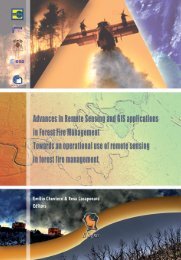Mapping microphytobenthos in the intertidal zone of Northern ...
Mapping microphytobenthos in the intertidal zone of Northern ...
Mapping microphytobenthos in the intertidal zone of Northern ...
You also want an ePaper? Increase the reach of your titles
YUMPU automatically turns print PDFs into web optimized ePapers that Google loves.
Figure 4. Inversion <strong>of</strong> data from <strong>the</strong> Bay <strong>of</strong> Somme May<br />
2002 campaign: a – simple band ratio; b – normalized<br />
ratio; c – scaled band area.<br />
Each technique was <strong>the</strong>n validated us<strong>in</strong>g a newly acquired data set <strong>in</strong> Baie de Somme (May 30, 2002). Chl a<br />
concentration was estimated by <strong>in</strong>vert<strong>in</strong>g <strong>the</strong> result<strong>in</strong>g functions and compared to <strong>the</strong> concentrations measured from<br />
<strong>the</strong> samples. As shown on Figure 4, <strong>the</strong>re is a strong correlation (R 2 > 0.9) between estimated and measured Chl a<br />
concentration, no matter which algorithm is used, for <strong>the</strong> range <strong>of</strong> Chl a concentrations encountered that day (50 –<br />
200 mg.m -2 ). More measurements under different conditions are still needed to crosscheck <strong>the</strong>se results.<br />
3.2. Airborne data<br />
In a first step, field reflectance spectra were convolved to airborne sensor bandpasses. New regressions were<br />
derived for <strong>the</strong> three approaches. Then a ratio image was produced as well as, after cont<strong>in</strong>uum removal, normalized<br />
402
















